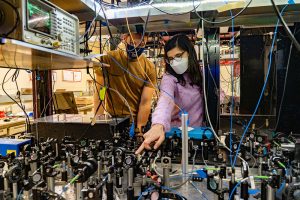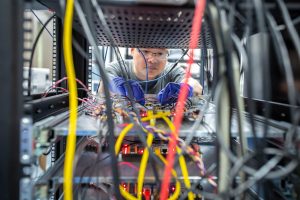Introduction
Quantum networking technologies are poised to transform the landscape of data communication, leveraging the principles of quantum mechanics to achieve unprecedented levels of security and efficiency. Unlike classical networks, which rely on bits as the fundamental unit of data, quantum networks use quantum bits or qubits. These qubits can exist in multiple states simultaneously, thanks to the phenomenon known as superposition, and can be entangled with other qubits, enabling instantaneous data transfer over vast distances.
Principles of Quantum Networking

1.Quantum Bits (Qubits)
Qubits are the cornerstone of quantum networking technologies. Unlike classical bits, which can be either 0 or 1, qubits can exist in a superposition of states. This property allows quantum networks to process and transmit information in ways that classical networks cannot.
2.Quantum Entanglement
Entanglement is a unique quantum phenomenon where two or more qubits become interconnected such that the state of one qubit instantly influences the state of the other, regardless of the distance separating them. This property is crucial for quantum networking, enabling secure and instantaneous communication.
3.Quantum Teleportation
Quantum teleportation is a method by which the state of a qubit is transferred from one location to another, without physically moving the qubit itself. This process relies on entanglement and classical communication and is a fundamental protocol for quantum networking.
4.Quantum Key Distribution (QKD)
QKD is a secure communication method that uses quantum mechanics to distribute encryption keys. It ensures that any attempt to eavesdrop on the key exchange will be detected, making it an essential component of quantum networking technologies.
Advancements in Quantum Networking Technologies

1.Quantum Repeaters
One of the significant challenges in quantum networking is the loss of signal over long distances. Quantum repeaters are devices that extend the range of quantum communication by entangling qubits over intermediate nodes. Recent advancements have led to the development of more efficient and reliable quantum repeaters, bringing us closer to global quantum networks.
2.Quantum Satellites
Quantum satellites represent a breakthrough in extending the reach of quantum networks. By transmitting entangled photons between ground stations, these satellites can establish secure communication links over thousands of kilometers. The successful launch and operation of quantum satellites, such as China’s Micius, demonstrate the feasibility of space-based quantum networking.
3.Integrated Quantum Photonics
Integrated quantum photonics involves the miniaturization of quantum components onto a single chip. This technology is crucial for the practical implementation of quantum networks, enabling scalable and cost-effective solutions. Advances in integrated quantum photonics have led to the development of more compact and efficient quantum devices.
4.Quantum Internet
The concept of a quantum internet involves a network of interconnected quantum computers and devices, enabling secure and instantaneous communication. Researchers are making significant strides toward realizing this vision, with experimental quantum networks already demonstrating key functionalities.
Applications of Quantum Networking Technologies

1.Secure Communication
One of the most promising applications of quantum networking technologies is secure communication. Quantum networks can provide unbreakable encryption, ensuring the confidentiality and integrity of transmitted data. This capability is particularly important for sensitive information in sectors such as finance, defense, and healthcare.
2.Quantum Computing
Quantum networking technologies are essential for the development and operation of quantum computers. By enabling the connection of quantum processors, these networks can facilitate distributed quantum computing, where complex computations are performed collaboratively across multiple quantum devices.
3.Scientific Research
Quantum networks can significantly enhance scientific research by enabling the precise and secure transfer of data between research facilities. This capability is crucial for collaborative projects that require the sharing of large datasets and complex computations.
4.Quantum Sensing
Quantum sensing involves the use of quantum systems to measure physical quantities with unprecedented precision. Quantum networks can enhance the capabilities of quantum sensors by enabling the secure and efficient transfer of sensor data, leading to advancements in fields such as environmental monitoring and medical diagnostics.
Challenges and Future Directions

Image by: Yandex.com
Despite the significant advancements in quantum networking technologies, several challenges remain. These include the development of more efficient quantum repeaters, the integration of quantum components into existing infrastructure, and the establishment of international standards and protocols.
Future research and development efforts will focus on addressing these challenges, with the ultimate goal of realizing a global quantum network. Such a network would not only revolutionize communication but also open up new possibilities for computing, sensing, and scientific discovery.
Conclusion
Quantum networking technologies represent a transformative leap in the field of communication, offering unparalleled security and efficiency. The advancements in quantum repeaters, satellites, integrated photonics, and the concept of a quantum internet are paving the way for a new era of connectivity. As research and development continue to overcome existing challenges, the potential applications of quantum networks will expand, driving innovation across various sectors and enhancing our ability to communicate and process information securely and efficiently.











